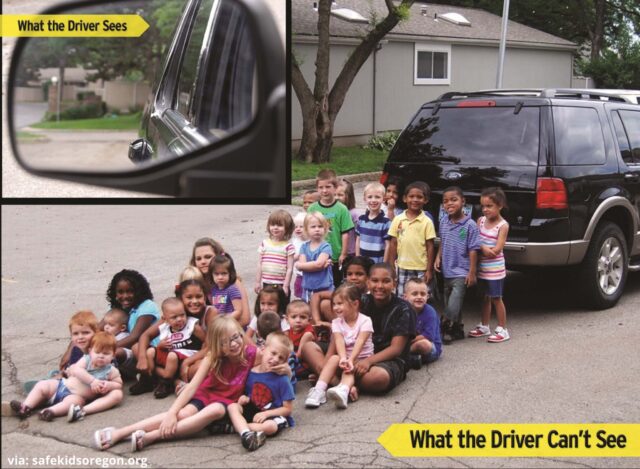Proposed federal safety regulations could make vehicle design safer for pedestrians and cyclists. USDOT is taking comments from the public–your city, your organization, your role as a parent, teacher, or just as a concerned resident–until June 8th. We need your voice.
It’s a crisis years in the making: vehicles are getting bigger and heavier, leading to a disturbing spike in traffic deaths.
New estimates from the National Highway Traffic Safety Administration (NHTSA) show that nearly 43,000 people died in crashes in 2021, an 11% jump from 2020. Fatalities and serious injuries among pedestrians and cyclists, in particular, have skyrocketed by more than 50% in the past decade, dramatically outpacing overall roadway deaths.
Data confirms the role of vehicle design in exacerbating the safety emergency unfolding on our nation’s streets, with studies from the Insurance Institute for Highway Safety (IIHS) and Consumer Reports documenting direct links between increased vehicle size and weight, reduced visibility from the driver’s seat and rising traffic fatalities.
However, under the federal government’s current safety rating system, known as the New Car Assessment Program (NCAP), almost every vehicle gets a four- or five-star rating. That’s because the system only takes into account the safety of those within cars, not all the people walking, pushing strollers, biking, or taking transit outside them.
In other words, current NCAP ratings don’t consider how likely someone walking down the street is to survive a crash with a vehicle, even a multi-ton truck or SUV. And larger vehicles have larger blind spots, resulting in backovers and low-visibility turns that cause hundreds of annual preventable deaths—including of many children.
Consumers should know whether the vehicles they’re buying are safe. But NHTSA’s current definition of vehicle safety is dangerously incomplete.
Now, federal regulators have an opportunity to address this public health catastrophe. Proposed rules from the National Highway Traffic Safety Administration (NHTSA) would begin rating cars based on their safety impacts to pedestrians. NACTO is encouraged to see NHTSA take this step towards incorporating safety features that protect people outside of vehicles.
Nevertheless, the proposed updates don’t address some of the current system’s largest deficiencies. The new rating system incorporates long-overdue technological changes, but misses opportunities to address the outsized role that vehicle design plays in determining safety outcomes.
Technology is important, but it can’t paper over basic design flaws. Recent studies have found that advanced driving assistance systems (ADAS), for example, frequently fail to protect people walking and biking on our streets. To truly improve safety outcomes for everybody, we also need significant changes to vehicle size, weight and driver visibility.

Image: SafeKidsOregon
That’s why NACTO is calling on NHTSA to improve the outdated and flawed way the U.S. rates the safety of vehicles, with these direct and impactful changes:
- NCAP ratings must consider pedestrian protection and survivability for people outside the vehicle, and testing protocols should prioritize smaller, more vulnerable road users. Vehicles that score poorly on pedestrian protection should be ineligible for 5-star ratings.
- NCAP ratings should consider visibility from the driver’s seat (also known as “direct vision”), ensuring vehicle size and hood-height don’t impede the driver’s ability to see in front of or around them. Cameras, mirrors and sensors cannot replace the need for direct sight, and tools to measure such visibility already exist. Vehicles with low direct visibility should be ineligible for 5-star ratings.
- Current ADAS technologies too frequently fail to spot bike riders and pedestrians. ADAS features must be evaluated based on their ability to sense and protect people outside the vehicle, and vehicles without sufficient protections should not receive 5-star ratings.
- Intelligent speed assistance, which is already mandatory on all new vehicles sold in the European Union, should be incorporated into NCAP, with 5-star ratings awarded only to systems that automatically lower a vehicle’s speed when it exceeds the posted speed limit.
You can read more about these proposed changes in NACTO’s full letter to NHTSA in the federal register.
The proposals are open for public comment until June 8th, and your feedback can help ensure NHTSA’s new rules are best designed to keep our streets safe.
To make your voice heard, download our template letter, which outlines the key changes regulators need to make to the program. Once you’ve made the letter your own, submit it to the federal register.

(Tip: Remember to copy or duplicate the Google Doc linked above to your own Drive or computer. On the federal register webpage, upload your letter as an attached document, rather than paste the text directly into the interface. Also note that the “what is your comment about?” question on the federal register webpage is optional.)
Many cities and transit agencies have also joined our call to make vehicles safer for everyone. You can read some of their statements on our Vehicle Design page.
It is critical that NHTSA recognizes vehicle design as a crucial component of street safety in cities, both to occupants of the vehicle and the people around it. The escalating safety crisis on our streets, with tens of thousands of preventable deaths each year, demands that we do more to save the lives of the most likely to be killed by poor vehicle design–kids on foot, older residents crossing the street, and people reaching their job by bike, especially in lower-income communities of color.